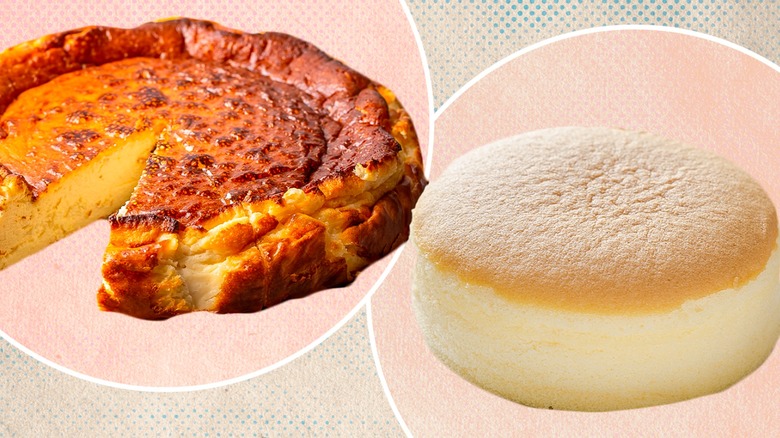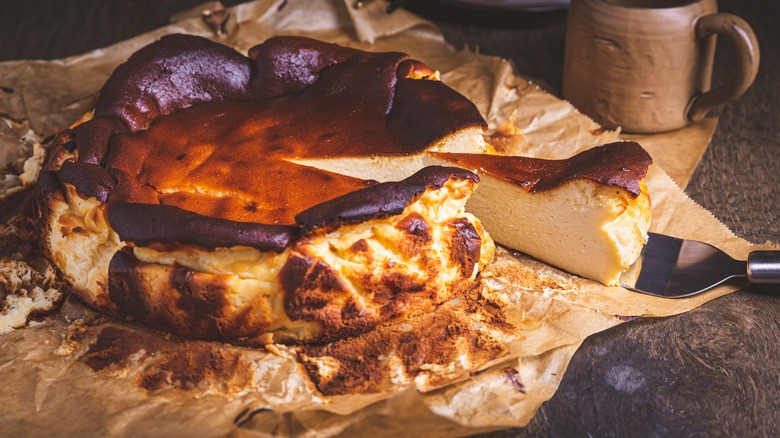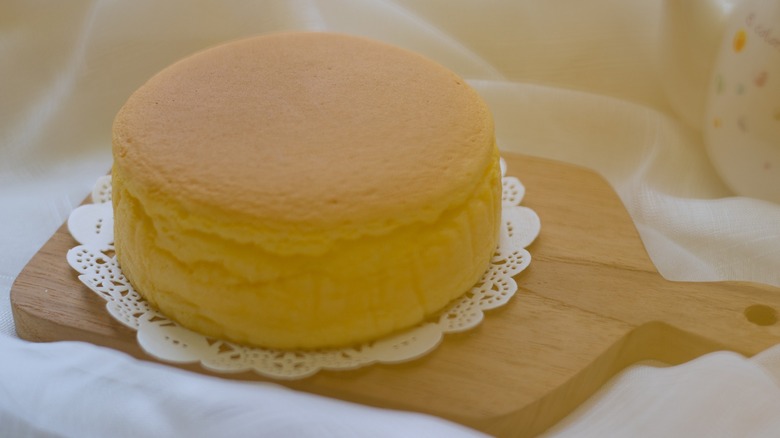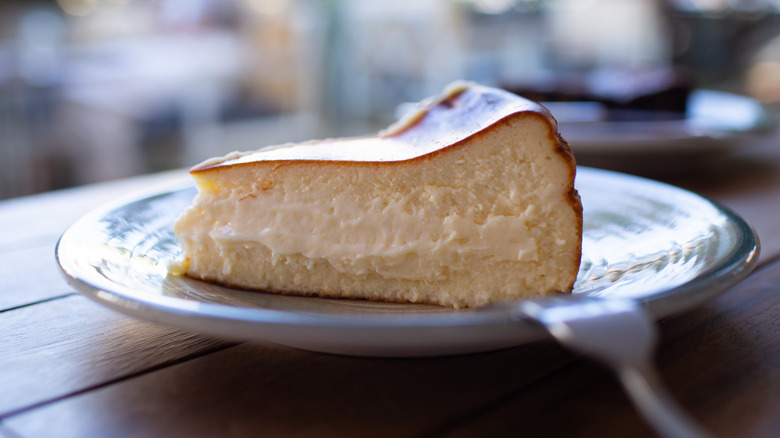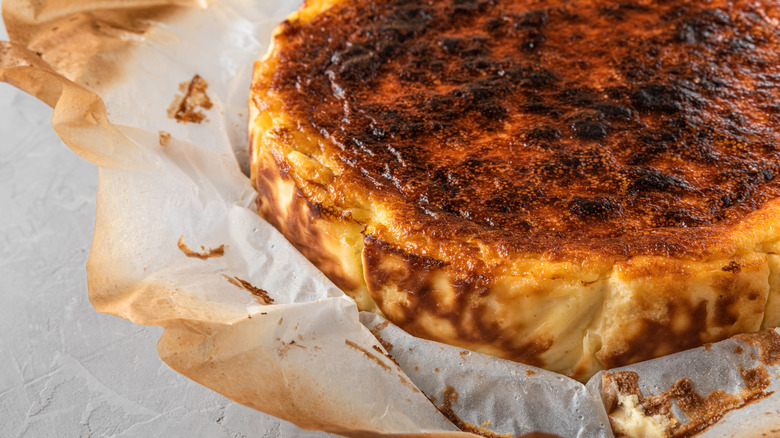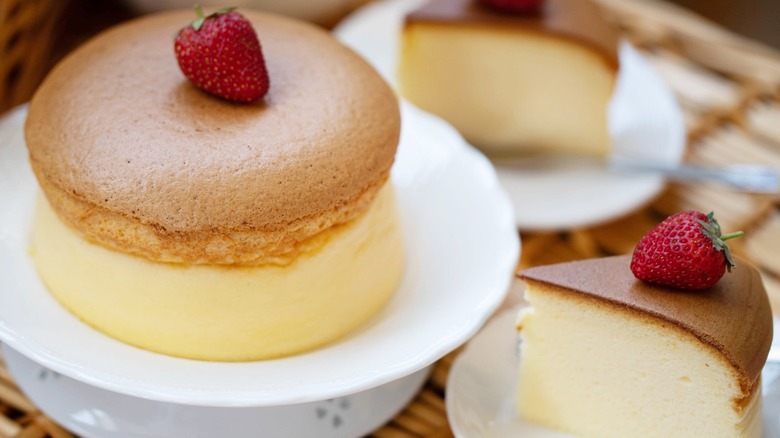Japanese Vs Basque Cheesecake: What's The Difference?
Dense, smooth, perfect cheesecake – the Platonic ideal that probably comes to mind when you hear the word "cheesecake" at all — is New York-style. New York-style cheesecake is the original version of the dessert, and it's made with a high ratio of cream cheese to eggs for a firm bite, rich texture, and strong, tangy, cream cheese-forward flavor. You know this already. What you might not know is that this classic dessert has inspired an entire confectionery family of regional spinoffs, and today, we're deep-diving into two of its most popular sisters: Japanese and Basque-style cheesecakes.
In order for a dessert to be a cheesecake it must consist of some mixture of cream cheese, butter, eggs, and sugar. The crust is not mandatory — which is good, because neither Japanese nor Basque cheesecake has it. They're also both typically served without toppings, allowing the flavorful desserts to speak for themselves. Perhaps most importantly, both treats are inventive, less sweet, and different-textured departures from the "classic" New York-style that can make a born-again cheesecake lover out of even the staunchest anti-cheesecake foodie. But that's about where the similarities between Japanese and Basque cheesecakes end.
What is Basque cheesecake?
What makes Basque cheesecake unique is its signature burnt surface and custardy interior. And that blackened top doesn't require a kitchen torch (a favorite culinary tool of the late great Anthony Bourdain). Instead, all the color and caramelized depth comes from the oven. Per the lore, this Spanish sweet was invented in the 1990s by chef Santiago Rivera, who took over his family's restaurant, La Viña, in San Sebastián, a settlement on the Bay of Biscay in northwest Spain (aka Basque Country). The restaurant's ovens, which were kept hot to crank out savory entrees, made a natural fit for prepping this now-global confectionery superstar.
To make Basque cheesecake, the cream cheese, sugar, and eggs are slowly creamed together, plus cream, vanilla, and sometimes lemon zest or salt. Then, the batter gets baked in a parchment paper-lined pan to an internal temperature of 150 to 155 degrees Fahrenheit, the crucial sweet spot for making a successful Basque cheesecake. If it's overcooked, the custardy center will be lost, and if undercooked, it'll be soupy and fall apart.
More than the cheese or eggs, that high heat is the key ingredient for its toasty intensity, richness, and depth. Pro tip: Bamonte's (the oldest Italian restaurant in Brooklyn) makes the best Basque cheesecake in the city. Or, if you're feeling ambitious and want to make it yourself at home, cracking a Basque cheesecake out of the parchment paper post-bake will be one of the most satisfying experiences of the week. You can even replicate the original La Viña Basque cheesecake recipe.
What is Japanese cheesecake?
Japanese cheesecake (aka soufflé cheesecake, Japanese cotton cake, or jiggly cake) is light, fluffy, and seems to be becoming more popular all the time. Even Trader Joe's sells Japanese cheesecake. The treat totes a creamy, butter yellow hue and a cloud-like texture that looks almost unreal in its perfect smooth puffiness. Think of the treat like sponge cake meets cheesecake — and, fittingly, it's simple yet wicked complicated to make.
Making Japanese cheesecake is a multi-step process that's very involved and hands-on. It's all in the technique. That magical puffiness comes from a mixture of cream cheese and meringue. In addition to the cream cheese, some folks also add heavy cream and sour cream for an extra velvety, soufflé-like texture. Either way, the double-boiler baking technique results in a cheesecake that is spongy-soft yet with a structurally intact body. You can squeeze it with your hand and it springs back, and it's dusted with a thin layer of powdered sugar on top for a cheery presentation.
This crustless cheesecake is not a traditional Japanese dessert. It started cropping up during the 1980s and quickly found an eager, sweet-toothed fanbase. As with many other dairy products, Japanese home bakers didn't have widespread access to cream cheese until after World War II. Per the lore, the dessert was invented in 1969 by Japanese pastry chef Tomotaro Kuzuno, who was inspired by the German cheesecake käsekuchen he had tasted during a trip to Berlin.
Basque cheesecake is eggy and sweet cheese-forward
Unlike the tangy cream cheese-forward flavor of New York-style cheesecake, fans love Basque cheesecake for its deep caramelization. The treat is known for its charred top and flan-like texture, which is made using a higher ratio of eggs and heavy cream than the Japanese style. That piquant sweet-bitter "burnt" top balances the ultra-rich custard insides, letting the flavor of the cheese shine. It's silky and eggy, more of a "sweet cheese" dessert with mouth-watering caramelized edges than the light, puffy Japanese cheesecake.
Plus, the parchment paper wrapping and the fact that it's sunken in the middle give Basque cheesecake a charming, rustic look compared to the perfect polished puffiness of Japanese cheesecake. Flavor-wise, Japanese cheesecake tastes similar to classic, tangy, not-too-sweet New York-style cheesecake, but is more airy than dense thanks to the meringue. That tangy flavor comes through in jiggly, bouncy bites, reminiscent of a moister sponge cake.
Basque cheesecake relies on high heat
With their vastly different appearances and textures, it's no surprise that Japanese and Basque cheesecakes are prepared quite differently. Basque style requires high heat for a short duration, and Japanese style is the opposite, all about low and slow baking. Basque cheesecake batter gets baked at a higher temperature, around 400 to 425 degrees Fahrenheit, for just 25 to 30 minutes. This heat is what sets the edges and surface and creates the custard-y inside texture. Some bakers even chill their batter beforehand to ensure that the center stays creamy without over-baking in the oven. For reference, New York-style cheesecake is baked at 350 degrees Fahrenheit.
On the flip side, Japanese cheesecake is baked a full 100 degrees cooler at 325 degrees Fahrenheit for roughly one hour. If you know that your home oven tends to run hot, it might be a good idea to dial it back to an even tamer 320 degrees Fahrenheit. Japanese cheesecakes are also cooled very slowly post-bake to keep the water locked inside and to prevent them from drying out or deflating and losing that painstakingly-created volume. To do this, bakers sometimes turn the oven off and leave the cheesecake in the oven for an additional hour post-bake, then slightly open the oven door for another 15 minutes. It's a delicate process, to say the least.
Japanese cheesecake requires a water bath to bake
While Basque cheesecake gets its crackled, charred looks from the oven, Japanese cheesecake gets its flawless appearance from a water bath (aka bain-marie). To make Japanese cheesecake, cream cheese and egg yolks are added to a double-boiler and cooked low, allowing the ingredients to slowly meld together into an even, smooth mixture that's heated gently and evenly. The egg whites are set aside and whipped into soft peaks for an airy meringue, which gets folded into the egg batter afterward, creating the cheesecake's aeration and structure. The water bath helps slow the water evaporating in the batter, making for a moister cake, and also helps prevent cracking.
Comparatively, Basque cheesecake is way more forgiving to make. Similarly, but less involved, to keep that trademark barely-set center intact, Basque cheesecake should be cooled at room temperature for one hour and chilled for another four hours before being removed from the pan. In both cases, a springform pan can be a helpful tool for unmolding these delicate cakes when you're ready to finally dig in, which is always the best part of all this labor.
